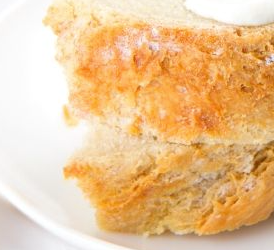Mastering the Art of Sourdough: A Comprehensive Guide to Crafting the Perfect Loaf
Embark on a culinary adventure and unlock the secrets of creating a classic with our Easy Sourdough Bread Recipe. Sourdough baking is an ancient art that has made a triumphant comeback in modern kitchens, offering a unique combination of robust flavor, chewy texture, and a golden, crackling crust. In this comprehensive guide, we’ll walk you through the steps to make your own sourdough bread, demystifying the process and empowering you to become a sourdough maestro in your home kitchen.
Ingredients:
For the Sourdough Starter:
- 1/2 cup all-purpose flour
- 1/2 cup lukewarm water
For the Bread Dough:
- 1 cup active sourdough starter
- 3 cups bread flour
- 1 and 1/2 teaspoons salt
- 1 cup lukewarm water
Instructions:
Creating the Sourdough Starter:
- Mix Flour and Water:
- In a glass or plastic container, combine 1/2 cup all-purpose flour with 1/2 cup lukewarm water. Stir well until no dry flour remains.
- Cover and Ferment:
- Cover the container loosely with a cloth or plastic wrap. Allow it to sit at room temperature for 24 hours. You should start seeing bubbles, a sign that the wild yeast is activating.
- Feed the Starter:
- Discard half of the starter and add 1/2 cup of flour and 1/2 cup of lukewarm water. Repeat this process daily for 5-7 days or until the starter is bubbly, has a pleasant tangy aroma, and doubles in size within 4-6 hours of feeding.
Making the Sourdough Bread:
- Mix Ingredients:
- In a large bowl, combine 1 cup of active sourdough starter, 3 cups of bread flour, salt, and 1 cup of lukewarm water. Mix until a sticky dough forms.
- Autolyse (Optional):
- Let the dough rest for 30 minutes. This autolyse step helps improve the dough’s extensibility and overall structure.
- Fold the Dough:
- Perform a series of folds every 30 minutes for the first 2 hours. To fold, wet your hands, grab one side of the dough, stretch it, and fold it over the rest of the dough. Repeat this on all four sides.
- Bulk Fermentation:
- Cover the bowl with a damp cloth and let the dough bulk ferment at room temperature for 6-12 hours or until it has doubled in size.
- Shape the Dough:
- Carefully transfer the dough onto a floured surface. Shape it into a round loaf by folding the edges towards the center, creating tension on the surface.
- Final Proof:
- Place the shaped dough in a floured proofing basket or a bowl lined with a cloth. Allow it to proof for 2-4 hours, or until it has increased in size.
- Preheat and Score:
- Preheat your oven to 450°F (232°C). Place a Dutch oven with the lid on in the oven to heat.
- Score the top of the dough with a sharp knife to allow for controlled expansion during baking.
- Bake in the Dutch Oven:
- Carefully place the proofed dough into the preheated Dutch oven. Cover with the lid and bake for 20 minutes. Remove the lid and bake for an additional 20-30 minutes or until the crust is golden brown.
- Cool and Enjoy:
- Allow the sourdough bread to cool on a wire rack before slicing. Enjoy the fruits of your labor with a slather of butter or your favorite toppings.
Cook Notes:
- Consistency of Starter: A bubbly and active starter is crucial for a successful sourdough bread. If the starter doesn’t double within 4-6 hours, continue the daily feeding process until it does.
- Hydration Adjustment: Depending on your flour and environmental conditions, you may need to adjust the water content in the dough to achieve the desired consistency.
- Folding Technique: The folding technique strengthens the gluten structure, contributing to a better rise and texture of the bread.
- Scoring Importance: Scoring the dough allows for controlled expansion during baking, preventing the bread from tearing in unpredictable ways.
Variations:
Whole Wheat Sourdough:
- Substitute a portion of the bread flour with whole wheat flour for a heartier, nuttier flavor.
Rosemary Olive Sourdough:
- Incorporate chopped fresh rosemary and Kalamata olives into the dough during the mixing process for a savory twist.
Cranberry Walnut Sourdough:
- Add dried cranberries and chopped walnuts to the dough during the folding stage for a sweet and nutty variation.
Keto Version:
- Unfortunately, creating a traditional keto-friendly sourdough is challenging due to the reliance on wheat flour. However, alternative flours like almond or coconut flour can be used for a different, low-carb bread.
Low-Carb Version:
- Substitute almond or coconut flour for traditional bread flour to reduce carb content.
- Use a low-carb sweetener in place of sugar in the starter, if desired.
- Experiment with seeds like flaxseed or chia for added texture and reduced carbs.
Congratulations! You’ve now ventured into the world of sourdough baking and crafted a delicious loaf from scratch. Sourdough is more than just bread; it’s a living, breathing creation that connects us to centuries-old traditions. As you savor each slice of your homemade sourdough, appreciate the patience and skill that went into its creation. Whether you’re a novice or a seasoned baker, this Easy Sourdough Bread Recipe is your gateway to the rich, tangy world of artisanal bread-making. Happy baking!

